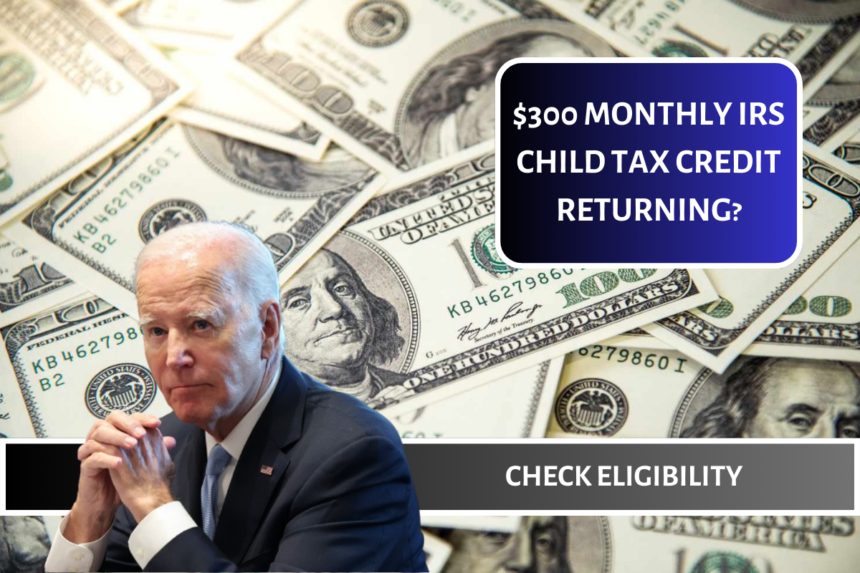By bringing back and expanding the Child Tax Credit (CTC), President Biden’s 2025 budget plan aims to fight child poverty and give families a lot of financial help. The idea for the proposal came from the successful growth of the CTC under the American Rescue Plan in 2021. This plan greatly reduced the number of poor children and provided vital aid to millions during the COVID-19 pandemic.
By raising the credit amounts and switching to monthly payments, the suggested changes are meant to make financial help more reliable and effective, making sure that families get help when they need it all year long.
This program is meant to help the economy right away, but it also aims to promote long-term growth and stability by directly improving families’ financial situations. The administration’s renewed attention on the CTC shows how serious they are about helping low- and middle-income families. It also shows how important government policy is in reducing economic inequality.
IRS GOV $300 Child Tax Credit Returning?
President Biden’s plan to bring back and improve the Child Tax Credit is a key step towards helping families in need with big amounts of money. The plan aims to help millions of American families, especially those dealing with poverty, get better financial relief more quickly and effectively by giving the credit in monthly installments and guaranteeing that it can be fully refunded. But the proposal’s future depends a lot on how it is received in Congress, where political differences could make it very hard to pass.
Key Features of the Proposed Child Tax Credit
- Increase in Credit Amounts: The credit amount would be raised from the current $2,000 per child to $3,600 for children under six years old, and $3,000 for children aged six and above.
- Monthly Payments: The expanded credit would be distributed in monthly payments of either $300 for children under six or $250 for older children, rather than being claimed annually during tax filing.
- Refundability: The credit would be fully refundable, meaning that families can receive the full amount of the credit even if it exceeds their total tax liability.
Impact on Poverty and Family Finances
As part of his 2025 budget, President Biden wants to increase the Child Tax Credit (CTC). This could help reduce poverty and make families in the United States more financially stable.
Reduction in Child Poverty
The Treasury Department says that the increase of the Child Tax Credit in 2021 cut child poverty by almost half, bringing it to an all-time low. Bringing back and improving this credit could have a huge effect on the number of poor people:
- Lifting Children Out of Poverty: The proposed expansion is projected to lift 3 million children out of poverty. This substantial reduction is achieved by providing families with direct financial support, helping them afford essentials such as food, clothing, and educational materials.
- Historical Comparison: The previous implementation of the expanded CTC during the pandemic led to a significant drop in child poverty rates, suggesting a strong correlation between direct financial support through tax credits and poverty alleviation.
Also See:- $2600 SNAP Checks 2024
Financial Relief for Families
The budget proposal extends beyond mere poverty reduction, offering broader financial relief:
- Tax Reduction: Families are expected to see an average tax reduction of $2,600, which represents a significant easing of the financial burdens for 39 million low-and-middle-income families. This reduction can help cover various costs and improve overall economic security.
- Monthly Payments: The proposal aims to smooth income fluctuations and provide more steady financial support throughout the year by providing the credit in monthly instalments rather than a yearly lump sum. This approach can help families manage monthly expenses more effectively and avoid high-cost debt options such as payday loans.
- Fully Refundable Credit: The full refundability of the credit ensures that even families with no tax liability can receive the full benefit, which is crucial for including the lowest-income households in the financial support system.
Overall Economic Impact
Putting these funds into the pockets of millions of Americans not only helps the people who are getting the credit, but it also boosts the economy. If families have more money to spend, they will probably buy more things. This can have a ripple effect on the economy, possibly creating jobs and boosting growth.
Political Landscape and Legislative Challenges
Even though the predictions are positive, Biden’s plan is likely to meet strong opposition from Republicans in Congress, which is a problem that similar plans have had in the past. The proposal’s success depends on how well it gets through the complicated congressional process. Other tax relief bills, like the Tax Relief for American Families and Workers Act, are also being thought about, but they are having trouble getting through the Senate.
